Human Flower Project
Wednesday, October 31, 2007
‘Not for All the Tea in the USA!’
After 5,000 years of picking, processing, brewing, and tax-evading, the Human-Tea project extends across the world. Drink up this stimulating report by James Wandersee and Renee Clary.
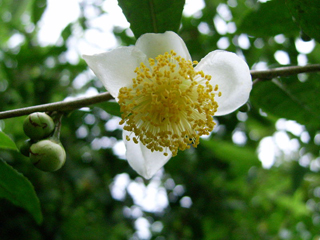
(L.) Kuntze (a.k.a. Tea)
Photo: Shizhao, via wiki
By James H. Wandersee and Renee M. Clary
EarthScholars™ Research Group
People are, right now, enjoying tea all across the world. Tea, in fact, is second only to water as the globe’s most popular beverage! Although the way it is processed, the vessels used to brew and drink it, the substances added to enhance its flavor, and the rituals associated with its consumption all may vary, tea drinking is global. Even so, it can be traced back to a single country and a single species.
Tea drinking began in China more than 5,000 years ago. Many historians credit China’s second emperor, a scientist named Shen Nung, with the discovery of tea-brewing in 2737 BCE, using the dried leaves of the plant that today’s botanists call Camellia sinensis (L.) Kuntze. This evergreen bush or medium-sized tree ranges from 6 to 50 feet tall when mature. A typical Tea* bush yields about 3,000 tea leaves a year. Although this may seem like a lot, it results in only 1 pound of processed tea. The highest quality tea is hand-plucked and only includes the tip bud and the two end-most leaves from each branch (“two flags and a spike”). Tea made from the first crop of tea leaves of the year is called “new tea.” It has the richest aroma and flavor, though the processing of tea also dramatically affects the final taste.
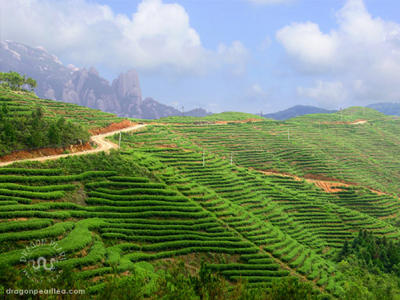
China’s Fujian Mountain Tea
Photo: Tea Dragon
Earth scientist Huang Shoubo (2007) has identified the environmental factors that account for the Tea plant’s yield and quality in high mountain areas of China. Shoubo concludes that many regional features are conducive to Tea growing here—“geology (topography, hydrology, soil), climate, and vegetation—but the climatological factors proved to be the most important.” Shoubo specifies the key ecological and climatic elements of China’s famous tea areas: “more amounts of clouds and fog, less percentage of sunshine, abundant rainfall and high relative humidity in the air, temperatures that rise and fall slowly, daily and annual temperature ranges that are smaller, more days that are suitable for tea growing and low wind speeds in the lee-sides and valleys of mountains. All of these factors are favorable for growth of Tea trees.”
Camellia sinensis (L.) Kuntze doesn’t sound like ancient Chinese. And it isn’t. The Tea plant was assigned this name in 1959 after several centuries of botanical debate, a decision based on the International Code of Nomenclature. The “L.” in the Tea plant’s scientific name tells us that it was originally classified by the famous Swedish taxonomist, Carolus Linnaeus (1707 – 1778). The word “Kuntze” that follows the “L.” indicates Linnaeus’ classification was revised by the German botanist-apothecary and world-traveler Otto Carl Ernst Kuntze (1843 – 1907). Linnaeus named the Tea plant’s genus “Camellia” after the Jesuit missionary Georg Joseph Kamel (1661 – 1706), “the people’s botanist of the Philippines,” who established the first free pharmacy for poor people.
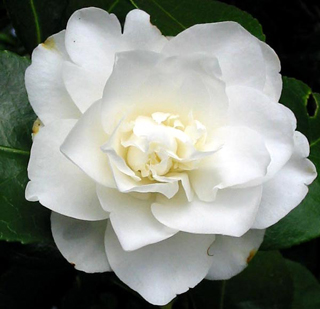
(Tea relative)
Photo: Moosey’s Country Garden
All of the world’s tea (other than the so-called herbal teas) is made from the leaves of that one small-white-flowered species of Camellia—a genus of plants otherwise known for its beautiful flowers, not leaves! Other Camellias are grown as ornamentals for their flowers.
Approximately 3,000 cultivars and hybrids have been selected by growers, many with double flowers. (A different species, Camellia japonica —often simply called Camellia by gardeners—is the most prominent floral species in cultivation, with over 2,000 named cultivated varieties in the colors of red, orange, pink, and white.)
“Not for all the tea in China!” is an expression many us have known since childhood. First used in Australia in the 1890s, this exclamation refers to the obscene amount of money it would take to entice the speaker to do something he or she would never do. The idiom demonstrates that China, being the birthplace of tea, maintains primacy of association with tea production. It also recalls that tea was initially a rich person’s drink in Europe. When the East India Tea Company first brought tea to Holland, it cost $100 per pound. Similarly, in England, tea gardens—lavish outdoor events featuring fancy flowers, food, and tea, accompanied by fireworks and gambling—gave tea drinking its exotic cachet. Tea and money were inextricably linked.
Admittedly, China does produce and export a lot of tea, but to the surprise of many India leads the world in tea output today. Interestingly, India and China also are the only double-digit consumers of the world’s annual tea production (India 23%; China 16%; USA 4%). America drinks more coffee than tea today, in part because John Hancock organized a boycott of Chinese tea that was sold to the colonies by the British East India Company. By 1773, that company was saddled with large debts and vast quantities of tea in its warehouses. The company had no prospect at all of selling it because smugglers, such as Hancock, were importing tea without paying the English their demanded import taxes. This was the “taxation without representation” that bothered the colonists.
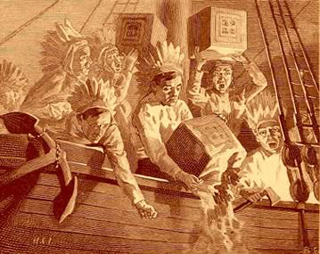 Boston Tea Party
Boston Tea Party
(dunking 45 tons)
Image: Early America
The Boston Tea Party of December 17, 1773 was a protest by the Sons of Liberty (a secret patriot organization resisting new Crown taxes and laws) that resulted in 45 tons of tea not yet unloaded from British ships being dumped into Boston Harbor. Thereafter, colonial patriots were urged to drink “Balsamic hyperion” (raspberry-leaf tea) or coffee instead. This social boycott of tea was not, however, long-lived. Tea-drinking resumed after the American Revolution. Indeed, USA’s China trade or tea trade began in 1784, when the new Empress of China, a merchant ship named for its destination, traveled to the Orient. In the 1880s, the USA became the biggest importer of tea, because of faster clipper ships and the ability to pay its debts in gold.
Although many of us still use the expression, “Not for all the tea in China!,” did you know that the US also produces tea? The contiguous United States has its very own 127-acre, working Charleston Tea Plantation on Wadmalaw Island in South Carolina’s Lowcountry. In fact, some of the most beautiful days of the entire growing season will occur at the plantation during October, as the Tea plants begin to bloom. By the end of the month, there should be millions of white Tea blossoms in every corner of the plantation. Visitors are welcome year-round (Wednesday through Saturday: 10 a.m. to 4 p.m.; Sunday: Noon to 4 p.m.). Tens of thousands have enjoyed the plantation’s bus ride through the “back-40” acres. The entire tour is free and ends at the Plantation Gift Shoppe. During the growing season, it is possible to experience the entire tea making process—from field to cup (or glass)—right before your own eyes.
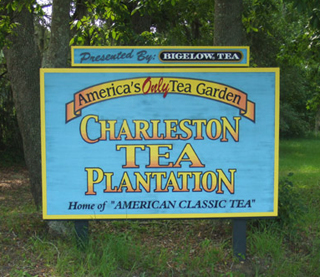 Tea plantation, Wadmalaw, SC
Tea plantation, Wadmalaw, SC
Photo: Bigelow Tea
Being from the South, your authors prefer the Plantation’s American Classic Tea, a black tea packaged in tea bags and intended for making fresh quarts or gallons of iced tea that we drink year-round. Why iced tea? “In 1904, Richard Blechynden, a tea vendor at the World’s Fair in St. Louis, weary of selling his cups of hot tea in the summer heat, dropped ice in the beverage in an attempt to boost sales. The result was the first iced tea, which has since become a hallmark of supper tables across the American South” (Bigelow Tea, 2007).
Tea growing in the continental USA has a checkered past. The US Government attempted it in South Carolina over a century ago on about 300 acres. Even though the plants grew well (from 1884 through 1888), production was not economically viable, so the operation was discontinued (Mitchell, 1907). From 1888 through 1915, Dr. Charles Shepard established and ran Pinehurst Tea Plantation and School near the federal government’s original South Carolina plot. There children obtained a free education, with a tea-based curriculum component, while helping grow and harvest award-winning teas.
In 1960, the Thomas J. Lipton Company (developer of the four-sided, Flo-Thru tea bag) bought the former Pinehurst Tea Plantation in Summerville, South Carolina. Dr. Shepard’s plantation had been abandoned since 1915. The Thomas J. Lipton Company, worried about instability of the world’s tea supply, rescued the surviving tea plants and moved them to a research facility constructed on Wadmalaw Island, South Carolina. Lipton later concluded, as the US government had almost 150 years before, that the unstable climate and high labor costs in South Carolina (8 times that in Asia) rendered American tea production economically unfeasible (SC Plantations, 2007).
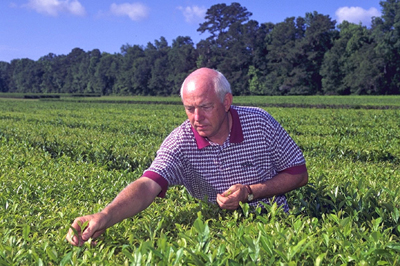
Mack Fleming, horticulturalist at the Charleston Tea Plantation
Photo: USDA
In 1987, horticultural researcher Mack Fleming and third-generation expert tea-taster William (Bill) Hall purchased the island tea farm from their former employer, the Thomas J. Lipton Company. They renamed it the Charleston Tea Plantation because it stands just 22 miles from Charleston. The tea was sold by mail-order and Sam’s Club. By 2003, Fleming and Hall encountered financial difficulties and the plantation was closed to the public until 2006. The Charleston Tea Plantation, “America’s Only Tea Garden,” is currently owned and operated by Bigelow Tea—a 60-year-old, family-owned company founded by Ruth Campbell Bigelow—which purchased it for $1.3 million in 2003. The company also sells internationally grown teas.
Since 1987, American Classic Tea has been the official tea of the White House. (Does your house have an “official” tea?)
If you would like to purchase some USA-grown tea, go to this website. If you would like to grow your own Tea plants and you live in planting zones 8 or 9 where the summers are hot and humid, see these recommendations.
Perhaps a new expression: “Not for all the tea in the USA!” will gain greater impact as time passes. In the year 2000, Francis Zee discovered a variety of Camellia sinensis, the Tea plant, that thrives in the rich volcanic soil and tropical climate of Hawaii. A collective of Hawaiian Tea growers is expected to have 240 acres of Tea under cultivation by 2008.
* Note that we follow the practice of capitalizing the Tea plant species’ common name, and not capitalizing tea when referring the commodity produced from this plant’s leaves [Cf. E.F. Potter, On Capitalization of Vernacular Names of Species, 1984].
Cooking • Culture & Society • Ecology • Secular Customs • Permalink




